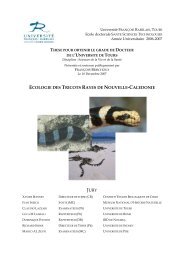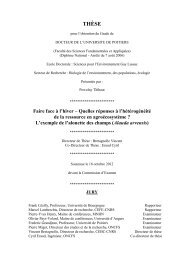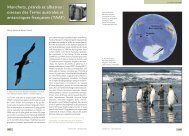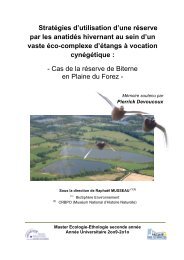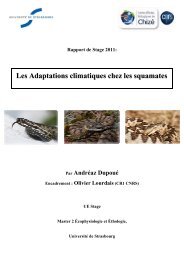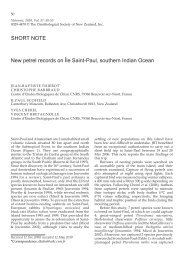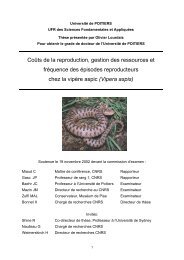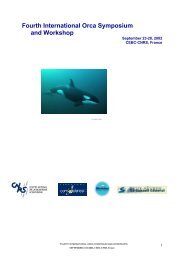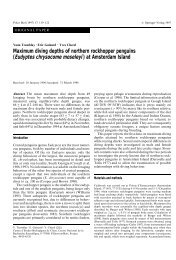Forçage environnemental et prédateurs marins ... - Cebc - CNRS
Forçage environnemental et prédateurs marins ... - Cebc - CNRS
Forçage environnemental et prédateurs marins ... - Cebc - CNRS
You also want an ePaper? Increase the reach of your titles
YUMPU automatically turns print PDFs into web optimized ePapers that Google loves.
March 2005 COSTS OF REPRODUCTION IN BLUE PETRELS<br />
685<br />
as a regional indicator of biophysical oceanographic<br />
conditions around the Kerguelen Islands. Oceanic phytoplankton<br />
and zooplankton productivity in the Southern<br />
Ocean is primarily limited by light and nutrients<br />
(phosphate, nitrate, silicate, and iron), and is affected<br />
by vertical mixing processes that deliver nutrients to<br />
the surface (Lewis <strong>et</strong> al. 1986, Uz <strong>et</strong> al. 2001). Primary<br />
productivity is impacted by the depth of the thermocline,<br />
a shallower thermocline increases the vertical<br />
flux of nutrients to the surface. Because an increase in<br />
SSH reflects an increase in the thermocline depth, SSH<br />
values are negatively correlated with the primary productivity<br />
at a global scale, but also in the Kerguelen<br />
region (Le Quéré <strong>et</strong> al. 2002, Wilson and Adamec<br />
2002). SSH was thus used as a proxy, because data on<br />
primary productivity, prey availability, or thermocline<br />
depths are temporally short or scarce. The Blue P<strong>et</strong>rel<br />
is a macrozooplankton and micronekton feeder, with<br />
crustaceans and fish forming the bulk of its food (Cherel<br />
<strong>et</strong> al. 2002); thus, SSH variations may indirectly<br />
affect, through the food web, food availability for Blue<br />
P<strong>et</strong>rels and, hence, their survival and reproductive success.<br />
SSH were obtained from the TOPEX/Poseidon<br />
(T/P) altim<strong>et</strong>er satellite (launched in August 1992; joint<br />
mission of NASA/CNES) measurements at the CLIOK-<br />
ER 1 station (5046 S, 6852 E) south of the Kerguelen<br />
archipelago (Topex information available online).<br />
2 SSH data are obtained by removing the tidal and<br />
m<strong>et</strong>eorological (wind and pressure) effects on sea level.<br />
Initial data were low-pass-filtered at 365 days so as to<br />
eliminate seasonal variability and to obtain the interannual<br />
variations (Park 2001).<br />
Each year when burrows were checked to d<strong>et</strong>ermine<br />
the breeding status of occupying birds, individuals<br />
were captured and weighed to the nearest 2 g with a<br />
300-g Pesola scale. For each year, an average body<br />
mass was calculated for each breeding state. Body mass<br />
was considered as a surrogate of physical body condition<br />
(i.e., the amount of body reserves) because structural<br />
measurements of body size such as culmen, tarsus,<br />
or wing length were not correlated with body mass<br />
(Pearson’s correlation coefficients: r 0.081, P <br />
0.276 for culmen; r 0.087, P 0.387 for tarsus; r<br />
0.121, P 0.035 for wing; all P’s Bonferroni corrected,<br />
n 523 birds). The effects of experience, breeding<br />
state, and year on changes in body mass were tested<br />
using a mixed-model ANOVA with the maximum likelihood<br />
m<strong>et</strong>hod (procedure MIXED, SAS version 8.02;<br />
SAS Institute 1999). Because some individuals were<br />
weighed on several occasions, ‘‘individual’’ was declared<br />
as a random effect.<br />
Covariates were tested through ultrastructural models<br />
in which survival probability is a function of SSH<br />
and/or body mass, following a linear-logistic function<br />
(Clobert and Lebr<strong>et</strong>on 1985):<br />
2 http://topex-www.jpl.nasa.gov<br />
[ ]<br />
<br />
logit() log covariate.<br />
(1 )<br />
Here is the intercept param<strong>et</strong>er and is a slope param<strong>et</strong>er.<br />
The confidence intervals around provide evidence<br />
of an effect. We concluded that covariates had<br />
an effect when their 95% confidence intervals did not<br />
include 0. The percentage of explained variation in<br />
survival of the full model that is explained by a covariate<br />
(r2 ) was estimated based on the ratio of differences<br />
in relative deviance (Dev) of constant, covariateand<br />
time-dependent models (Schemper 1990):<br />
Dev(covariate) Dev(constant)<br />
2 rQDdev .<br />
Dev(t) Dev(constant)<br />
Here covariate, t, and constant are the covariate-dependent,<br />
time-dependent, and constant survival rates,<br />
other things being equal.<br />
Model selection and goodness of fit<br />
Our selection of models for estimation was based on<br />
model goodness-of-fit (GOF) tests and a second-order<br />
Akaike’s Information Criterion, which is a small-sample<br />
bias adjustment (AIC c; Burnham and Anderson<br />
2002). The GOF test of the most general model was<br />
performed to d<strong>et</strong>ermine wh<strong>et</strong>her this model provided<br />
an adequate description of the data. AIC c selects the<br />
model that is best in terms of both parsimony and quality<br />
of fit to the data. The model in which AIC c is minimized<br />
is selected as best for describing the data. Evidence<br />
for each of the alternative models was evaluated<br />
using change in AIC c, calculated as iAIC c ( i) values<br />
(Anderson <strong>et</strong> al. 2000). As a general guideline, i values<br />
2 are a good indication that the model with the<br />
lower AIC c is preferable, whereas i values 2 indicate<br />
that models are fairly similar in their abilities to describe<br />
the data (Lebr<strong>et</strong>on <strong>et</strong> al. 1992). The likelihood<br />
of a model, given the data, was estimated with a likelihood-based<br />
inference approach with AIC c weights<br />
(w i) calculated following Anderson <strong>et</strong> al. (2000):<br />
<br />
1<br />
exp i 2<br />
wi <br />
R 1 exp r<br />
2<br />
.<br />
r1<br />
<br />
Here, for a s<strong>et</strong> of R models, i is the AIC c difference<br />
b<strong>et</strong>ween model i and the lowest AIC c model. The rel-<br />
ative likelihood of model i vs. j is wi/wj. To verify wh<strong>et</strong>her our most general model ( Sr r<br />
t, pt,<br />
rs t ) reasonably fits the data, we used a GOF test re-<br />
cently made available for multistate mark–recapture<br />
models (Pradel <strong>et</strong> al. 2003). We used program U-Care<br />
(Choqu<strong>et</strong> <strong>et</strong> al. 2003a) to assess the fit of our general<br />
model. Because we d<strong>et</strong>ected significant lack of fit (see<br />
Results: Goodness-of-fit tests), we calculated a variance<br />
inflation factor (ĉ) to account for that extra-binomial<br />
variation. The inflation factor was calculated as the



